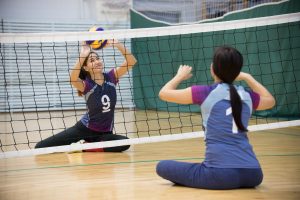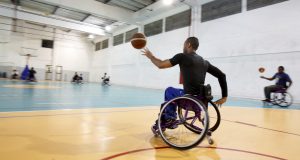In 2017, 6.2 million Canadians reported having a disability and it was estimated that only 3% of those individuals engaged in regular organized physical activity (Statistics Canada, 2017; Government of Canada, 2012). Of the often-limited opportunities available, individuals experiencing disability may choose to participate through either segregated or integrated programs.
Segregated sport programs are typically comprised of only individuals who experience disability and are designed to meet individual needs based on impairment (Spencer-Cavaliere, Thai, & Kingsley 2017). In the 1990s, the process of integration of individuals experiencing disability into many mainstream sports began (e.g., athletics, swimming, cross country skiing). Integration has been broadly defined as the equal access and acceptance of all who would like to participate (Howe, 2007). Integration policy has been initiated through a top down approach, starting with national level organizations and trickling down to the community level. Theoretically, community clubs of integrated sports are supposed to be fully integrated to support all athletes experiencing disability. But this is easier said than done.

In Canada, integration in mainstream sport has been a long, slow process. At the community level, researchers have shown that integration is not happening as effectively as it could be (Howe, 2007; Kitchin, Peile, & Lowther, 2019; Peers, Konoval, & Naturkach, 2020). Community sport clubs confront a number of barriers, including a lack of trained coaches, limited availability of interested coaches/volunteers, limited human resources, equipment, accessible training spaces and inadequate budgets. They also report confusion and lack confidence in identifying what the integration policy is, what it means, and how it should be implemented at the local level. To help tackle these barriers and support clubs in delivering more effective integrated sport opportunities, The Steadward Centre for Personal & Physical Achievement at the University of Alberta has created a resource called Becoming Para Ready.
The Becoming Para Ready Resource
The Becoming Para Ready resource has been developed as an introductory technical guide to provide coaches and club administrators with knowledge, confidence, and tools to be more proactive – or “ready” – for integration, and to introduce the ways integration can be implemented. “Para Ready” means clubs are prepared to support athletes experiencing disability in some way, by either providing programming or connecting to those that do. Para Ready clubs have proactively planned, prepared, and can be explicit about the ways they can and cannot support all athletes, rather than reacting when contacted by an athlete experiencing disability. The resource was developed for the sport of athletics; however, it can be used for any sport club that wants to learn how to make programs more inclusive.
Athletics offers opportunities for almost all athletes across disability groups to participate, making it a highly inclusive sport. However, more often than not, only athletes who can be most easily accommodated actually get to participate. The Becoming Para Ready resource helps provide grassroot sport organizations with the tools required to effectively support the participation of athletes experiencing disability in sport.
The Para Ready Continuum

Para Ready doesn’t mean that a program needs to start a para program. Instead, programs can be Para Ready by either providing or supporting programming or connecting to those programs that do. There are many places clubs may land within the three categories of the Para Ready Continuum:
- Connectors – Some sport organizations are not able to start a new para program but can research where the closest para programs are located. To be a connector, organizations should have a clear idea of where local para program coaches are located and develop a referral plan to connect potential athletes experiencing disability to local programming. For example, a small alpine ski club that can’t start a specific para program due to cost, human resources, knowledge, etc., can reach out to local and provincial/territorial/disability sport organizations to understand what is available in the community. Organizations should be prepared to link athletes experiencing disability to a program that can support them best. Recently, Peers, Konoval and Naturkach (2020) suggested sport clubs could provide a working link on their club website for potential athletes to access information about how they can participate. For more information on what details should be included on your website, check out viasport’s blog here.
- Contributors – These sport organizations can offer their resources (e.g., facilities, equipment, volunteers) to informally support other sport organizations delivering programming for and supporting para athletes. Contributors can also provide programming information and links on their website. This might be an athletics club that has, for example, a number of racing wheelchairs but no coach with wheelchair racing technical knowledge. Contributors may have the capacity to support some para athlete classifications but not others (related to availability of specialized equipment, coach education/expertise, or level of support needed).
- Collaborators – Collaborators have the means to start (or currently run) para programming, or have established a formal partnership with another organization delivering programs. For example, a large swim club who wants to expand their offerings to more programming to more people could seek to partner with another club, or could integrate para athletes into existing programming. Both models have their pros and cons.
Nine P’s of a Para Ready Program

The Becoming Para Ready resource outlines the nine P’s of a Para Ready program: Proactive, Policy, Promotion, Programming, People, Place, Pathway, Price, and Partnership. The nine P’s are meant to guide leaders along the pathway to becoming a Para Ready program. Being Proactive, the first of the nine P’s, is essential and provides an umbrella over the other P’s – clubs need to be proactive to be more inclusive. Examples of other P’s include:
People – Find the coach(es) who will champion your para program and provide them with para coach education, such as coaching athletes with a disability. This might be a cycling club that has a coach who has shown a strong interest in adapting or modifying workouts and equipment for athletes experiencing disability. The club can support this coach’s development by directing them to available para coach training opportunities, and reaching out to the provincial/territorial sport organization to connect the club coach with an experienced para coach mentor. Being proactive means having trained people in place so athletes experiencing disability feel confident in the support they will receive through your club.
Promotion – Program promotion (e.g., websites, posters, communications) should include at least these key details: accessibility information; local transportation options; parking; specialized equipment available; level of challenge; and coach certification. This might be a triathlon club that has ensured its website meets accessibility requirements (i.e., all pictures have alt text), and clearly states that their program supports athletes experiencing disability and which disability groups they are capable of coaching. The website lists all equipment available (e.g., wheelchair racing chair, handcycle), coach certification and experience, and accessible facility features (e.g., parking, washrooms, track location, pool entry). Social media posts use inclusive language that is easy to understand, and images that show all the diverse athletes involved in their program. Being proactive means evaluating all promotions and communications before they are posted to ensure they represent “all” athletes who are welcome to join your club.
Check out the remaining P’s in the Becoming Para Ready resource and access the detailed toolkit to help you on your way.